RENAULT DUSTER 2016 Owner's Guide
Manufacturer: RENAULT, Model Year: 2016, Model line: DUSTER, Model: RENAULT DUSTER 2016Pages: 256, PDF Size: 6.49 MB
Page 31 of 256
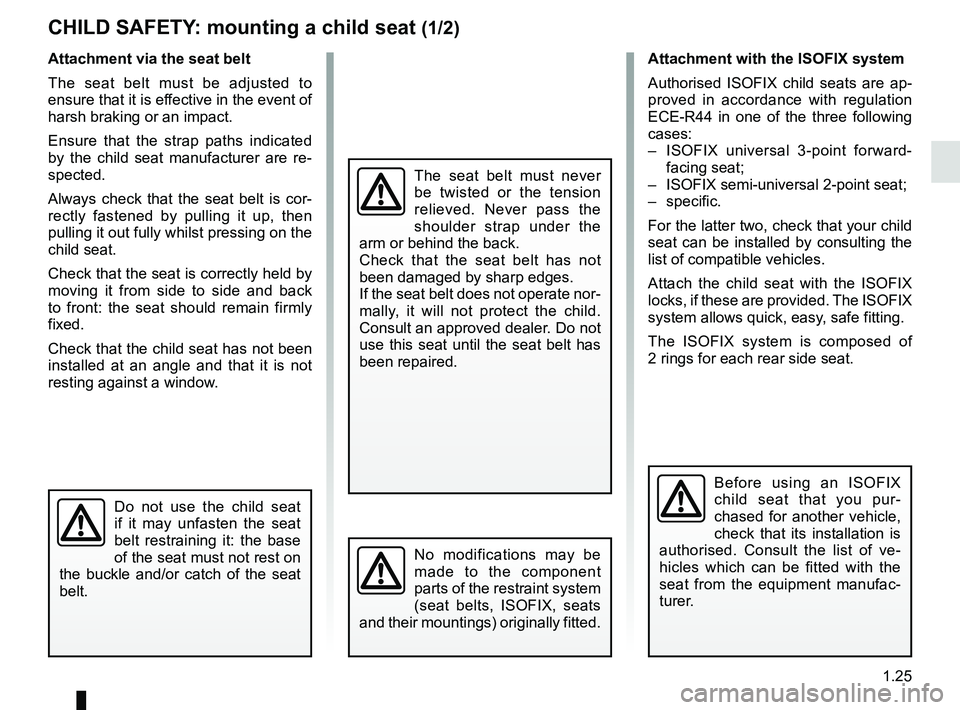
1.25
CHILD SAFETY: mounting a child seat (1/2)
Attachment via the seat belt
The seat belt must be adjusted to
ensure that it is effective in the event of
harsh braking or an impact.
Ensure that the strap paths indicated
by the child seat manufacturer are re-
spected.
Always check that the seat belt is cor-
rectly fastened by pulling it up, then
pulling it out fully whilst pressing on the
child seat.
Check that the seat is correctly held by
moving it from side to side and back
to front: the seat should remain firmly
fixed.
Check that the child seat has not been
installed at an angle and that it is not
resting against a window.Attachment with the ISOFIX system
Authorised ISOFIX child seats are ap-
proved in accordance with regulation
ECE-R44 in one of the three following
cases:
– ISOFIX universal 3-point forward-
facing seat;
– ISOFIX semi-universal 2-point seat;
– specific.
For the latter two, check that your child
seat can be installed by consulting the
list of compatible vehicles.
Attach the child seat with the ISOFIX
locks, if these are provided. The ISOFIX
system allows quick, easy, safe fitting.
The ISOFIX system is composed of
2 rings for each rear side seat.
Before using an ISOFIX
child seat that you pur-
chased for another vehicle,
check that its installation is
authorised. Consult the list of ve-
hicles which can be fitted with the
seat from the equipment manufac-
turer.
No modifications may be
made to the component
parts of the restraint system
(seat belts, ISOFIX, seats
and their mountings) originally fitted.
The seat belt must never
be twisted or the tension
relieved. Never pass the
shoulder strap under the
arm or behind the back.
Check that the seat belt has not
been damaged by sharp edges.
If the seat belt does not operate nor-
mally, it will not protect the child.
Consult an approved dealer. Do not
use this seat until the seat belt has
been repaired.
Do not use the child seat
if it may unfasten the seat
belt restraining it: the base
of the seat must not rest on
the buckle and/or catch of the seat
belt.
Page 32 of 256
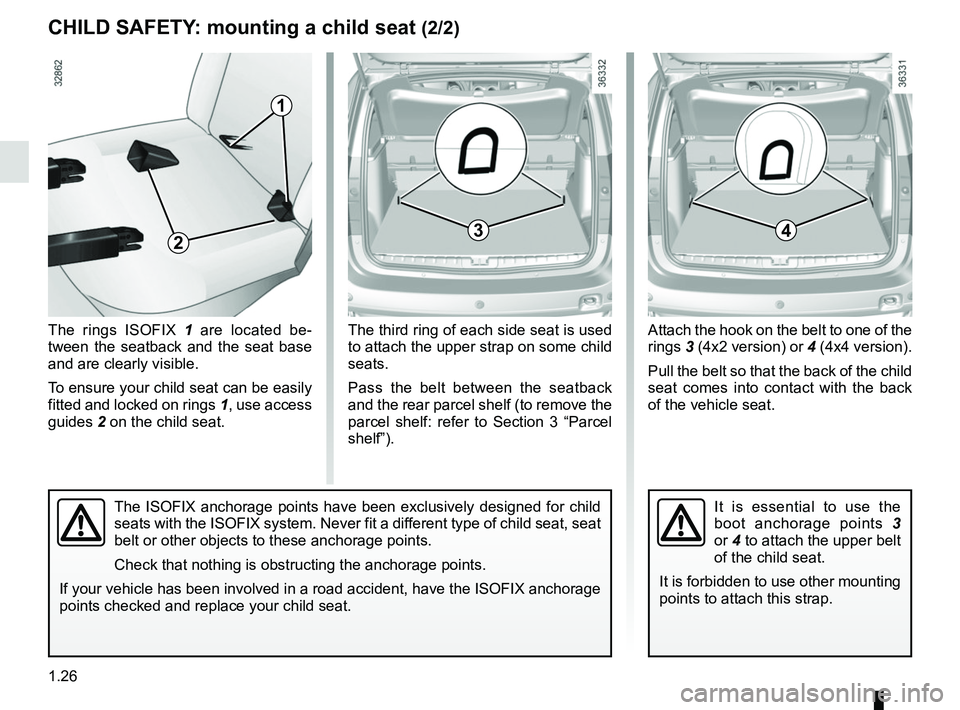
1.26
Attach the hook on the belt to one of the
rings 3 (4x2 version) or 4 (4x4 version).
Pull the belt so that the back of the child
seat comes into contact with the back
of the vehicle seat.The third ring of each side seat is used
to attach the upper strap on some child
seats.
Pass the belt between the seatback
and the rear parcel shelf (to remove the
parcel shelf: refer to Section 3 “Parcel
shelf”).
The rings ISOFIX 1
are located be-
tween the seatback and the seat base
and are clearly visible.
To ensure your child seat can be easily
fitted and locked on rings 1, use access
guides 2 on the child seat.
The ISOFIX anchorage points have been exclusively designed for child
seats with the ISOFIX system. Never fit a different type of child seat, seat
belt or other objects to these anchorage points.
Check that nothing is obstructing the anchorage points.
If your vehicle has been involved in a road accident, have the ISOFIX an\
chorage
points checked and replace your child seat.
CHILD SAFETY: mounting a child seat (2/2)
It is essential to use the
boot anchorage points 3
or 4 to attach the upper belt
of the child seat.
It is forbidden to use other mounting
points to attach this strap.
43
1
2
Page 33 of 256
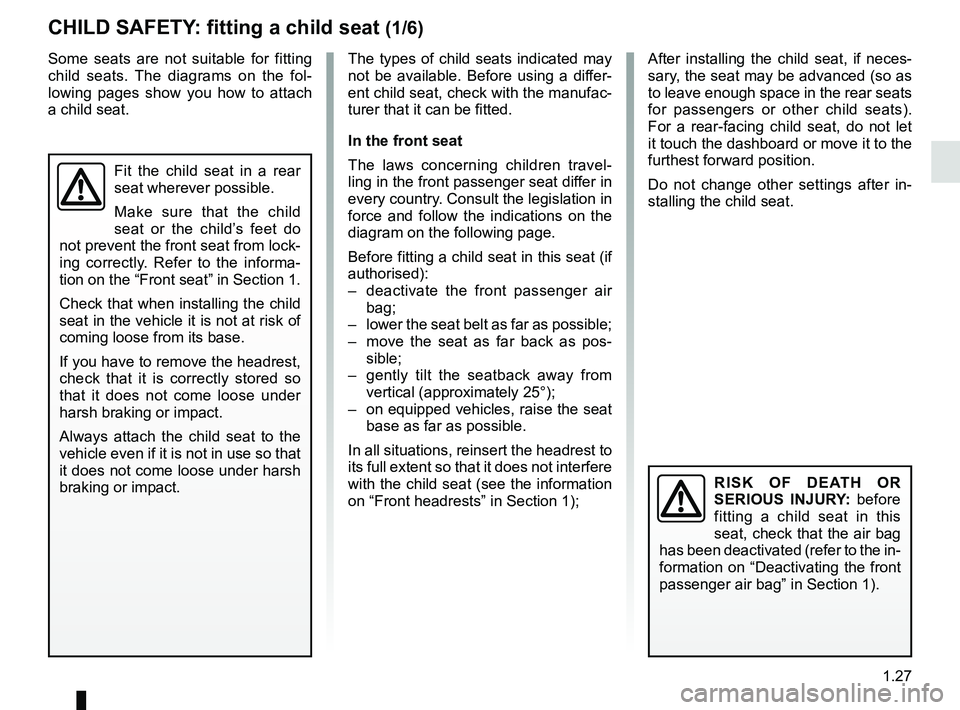
1.27
CHILD SAFETY: fitting a child seat (1/6)
The types of child seats indicated may
not be available. Before using a differ-
ent child seat, check with the manufac-
turer that it can be fitted.
In the front seat
The laws concerning children travel-
ling in the front passenger seat differ in
every country. Consult the legislation in
force and follow the indications on the
diagram on the following page.
Before fitting a child seat in this seat (if
authorised):
– deactivate the front passenger air bag;
– lower the seat belt as far as possible;
– move the seat as far back as pos- sible;
– gently tilt the seatback away from vertical (approximately 25°);
– on equipped vehicles, raise the seat base as far as possible.
In all situations, reinsert the headrest to
its full extent so that it does not interfere
with the child seat (see the information
on “Front headrests” in Section 1);
RISK OF DEATH OR
SERIOUS INJURY: before
fitting a child seat in this
seat, check that the air bag
has been deactivated (refer to the in-
formation on “Deactivating the front
passenger air bag” in Section 1).
Some seats are not suitable for fitting
child seats. The diagrams on the fol-
lowing pages show you how to attach
a child seat.
Fit the child seat in a rear
seat wherever possible.
Make sure that the child
seat or the child’s feet do
not prevent the front seat from lock-
ing correctly. Refer to the informa-
tion on the “Front seat” in Section 1.
Check that when installing the child
seat in the vehicle it is not at risk of
coming loose from its base.
If you have to remove the headrest,
check that it is correctly stored so
that it does not come loose under
harsh braking or impact.
Always attach the child seat to the
vehicle even if it is not in use so that
it does not come loose under harsh
braking or impact.
After installing the child seat, if neces-
sary, the seat may be advanced (so as
to leave enough space in the rear seats
for passengers or other child seats).
For a rear-facing child seat, do not let
it touch the dashboard or move it to the
furthest forward position.
Do not change other settings after in-
stalling the child seat.
Page 34 of 256
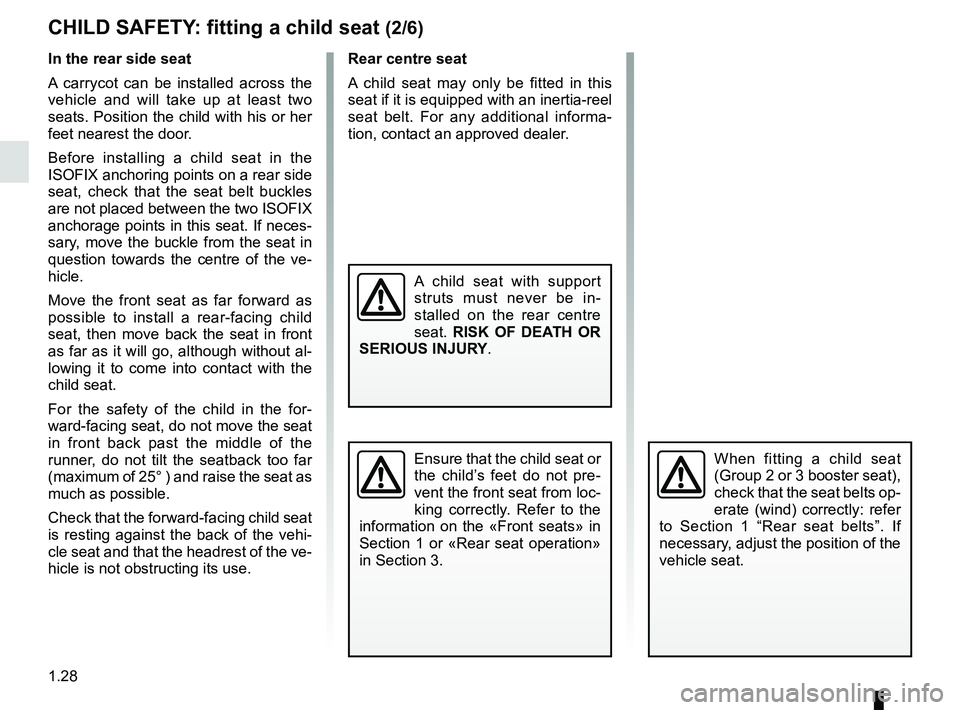
1.28
CHILD SAFETY: fitting a child seat (2/6)
Rear centre seat
A child seat may only be fitted in this
seat if it is equipped with an inertia-reel
seat belt. For any additional informa-
tion, contact an approved dealer.In the rear side seat
A carrycot can be installed across the
vehicle and will take up at least two
seats. Position the child with his or her
feet nearest the door.
Before installing a child seat in the
ISOFIX anchoring points on a rear side
seat, check that the seat belt buckles
are not placed between the two ISOFIX
anchorage points in this seat. If neces-
sary, move the buckle from the seat in
question towards the centre of the ve-
hicle.
Move the front seat as far forward as
possible to install a rear-facing child
seat, then move back the seat in front
as far as it will go, although without al-
lowing it to come into contact with the
child seat.
For the safety of the child in the for-
ward-facing seat, do not move the seat
in front back past the middle of the
runner, do not tilt the seatback too far
(maximum of 25° ) and raise the seat as
much as possible.
Check that the forward-facing child seat
is resting against the back of the vehi-
cle seat and that the headrest of the ve-
hicle is not obstructing its use.
Ensure that the child seat or
the child’s feet do not pre-
vent the front seat from loc-
king correctly. Refer to the
information on the «Front seats» in
Section 1 or «Rear seat operation»
in Section 3.
A child seat with support
struts must never be in-
stalled on the rear centre
seat. RISK OF DEATH OR
SERIOUS INJURY.
When fitting a child seat
(Group 2 or 3 booster seat),
check that the seat belts op-
erate (wind) correctly: refer
to Section 1 “Rear seat belts”. If
necessary, adjust the position of the
vehicle seat.
Page 35 of 256

1.29
CHILD SAFETY: fitting a child seat (3/6)
Using a child safety system
which is not approved for
this vehicle will not correctly
protect the baby or child.
They risk serious or even fatal injury.
³ Check the status of the air bag
before fitting a child seat or allowing a
passenger to use the seat. Vehicles without air bag OR with air bag deactivated
RISK OF DEATH OR
SERIOUS INJURY: before
installing a child/baby seat
on the front passenger seat,
check that the air bag has been de-
activated (refer to “Deactivating the
front passenger air bag” at the end
of the paragraph).
Child seat attached using the ISOFIX
mounting
ü Seat which allows an ISOFIX
child seat to be fitted.
± The rear seats are fitted with
an anchorage point which allows a
forward-facing ISOFIX child seat with
universal approval to be fitted. The an-
chorage points are located under the
luggage compartment carpet and are
indicated by a marking.
The size of the ISOFIX child seat is in-
dicated by a letter:
– A, B and B1: for forward-facing seats in group 1 (9 to 18 kg);
– C: rear-facing seats in group 1 (9 to 18 kg);
– D and E: shell seat or rear-facing seats in group 0 or 0+ (less than
13 kg);
– F and G: cots in group 0 (less than 10 kg).
² Seat not suitable for fitting child
seats.
¬ Seat which allows a child seat
with “Universal” approval to be attached
by a seat belt.
Only if the seat is equipped with an
inertia-reel belt.
1
1
Page 36 of 256
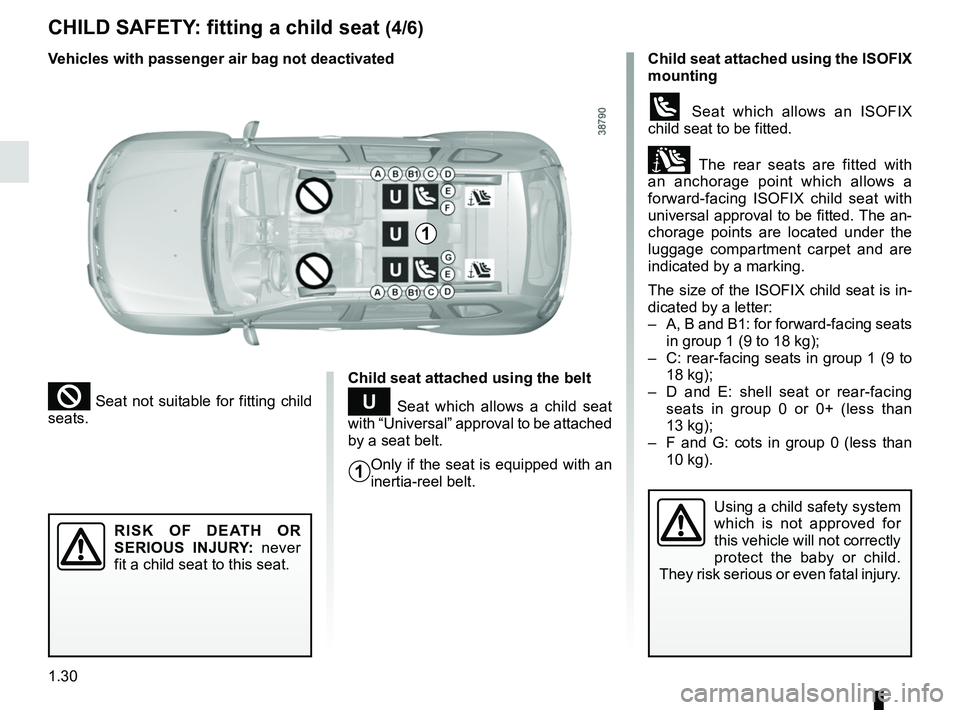
1.30
CHILD SAFETY: fitting a child seat (4/6)
Child seat attached using the belt
¬ Seat which allows a child seat
with “Universal” approval to be attached
by a seat belt.
Only if the seat is equipped with an
inertia-reel belt.
Using a child safety system
which is not approved for
this vehicle will not correctly
protect the baby or child.
They risk serious or even fatal injury.
² Seat not suitable for fitting child
seats. Vehicles with passenger air bag not deactivated
RISK OF DEATH OR
SERIOUS INJURY: never
fit a child seat to this seat.
Child seat attached using the ISOFIX
mounting
ü Seat which allows an ISOFIX
child seat to be fitted.
± The rear seats are fitted with
an anchorage point which allows a
forward-facing ISOFIX child seat with
universal approval to be fitted. The an-
chorage points are located under the
luggage compartment carpet and are
indicated by a marking.
The size of the ISOFIX child seat is in-
dicated by a letter:
– A, B and B1: for forward-facing seats in group 1 (9 to 18 kg);
– C: rear-facing seats in group 1 (9 to 18 kg);
– D and E: shell seat or rear-facing seats in group 0 or 0+ (less than
13 kg);
– F and G: cots in group 0 (less than 10 kg).
1
1
Page 37 of 256
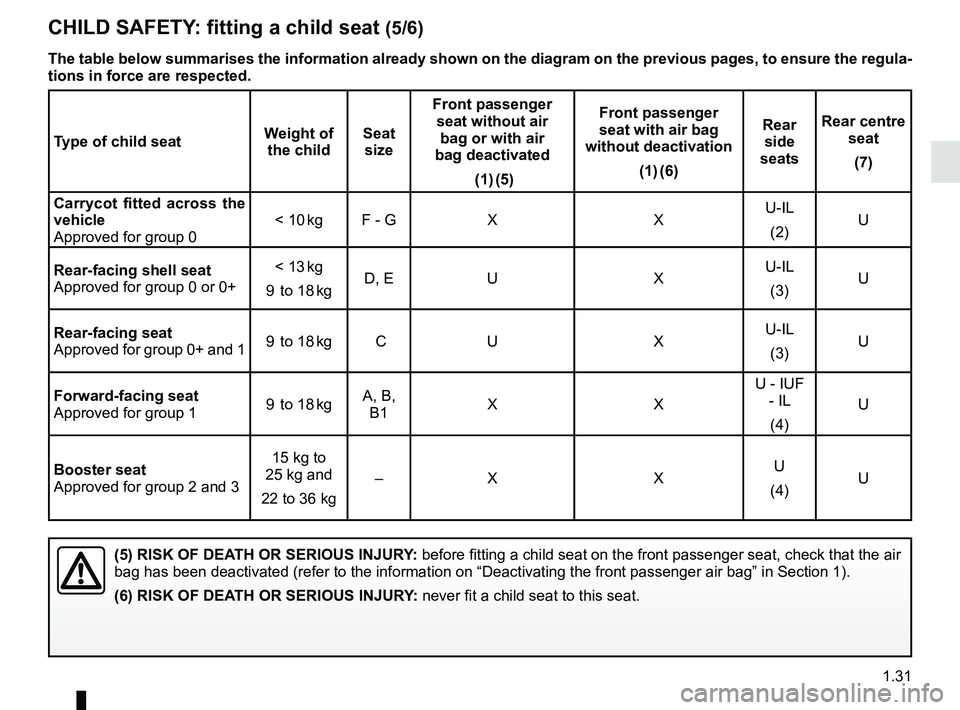
1.31
CHILD SAFETY: fitting a child seat (5/6)
(5) RISK OF DEATH OR SERIOUS INJURY: before fitting a child seat on the front passenger seat, check that the\
air
bag has been deactivated (refer to the information on “Deactivating \
the front passenger air bag” in Section 1).
(6) RISK OF DEATH OR SERIOUS INJURY: never fit a child seat to this seat.
The table below summarises the information already shown on the diagram \
on the previous pages, to ensure the regula-
tions in force are respected.
Type of child seat Weight of
the child Seat
size Front passenger
seat without air bag or with air
bag deactivated
(1) (5) Front passenger
seat with air bag
without deactivation
(1) (6) Rear
side
seats Rear centre
seat
(7)
Carrycot fitted across the
vehicle
Approved for group 0 < 10
kg F - G X X U-IL
(2) U
Rear-facing shell seat
Approved for group 0 or 0+ < 13
kg
9 to 18 kg D, E
U XU-IL
(3) U
Rear-facing seat
Approved for group 0+ and 1 9
to 18 kg C UXU-IL
(3) U
Forward-facing seat
Approved for group 1 9
to 18 kg A, B,
B1 XX U - IUF
- IL
(4) U
Booster seat
Approved for group 2 and 3 15 kg to
25 kg and
22 to 36 kg –X X
U
(4) U
Page 38 of 256
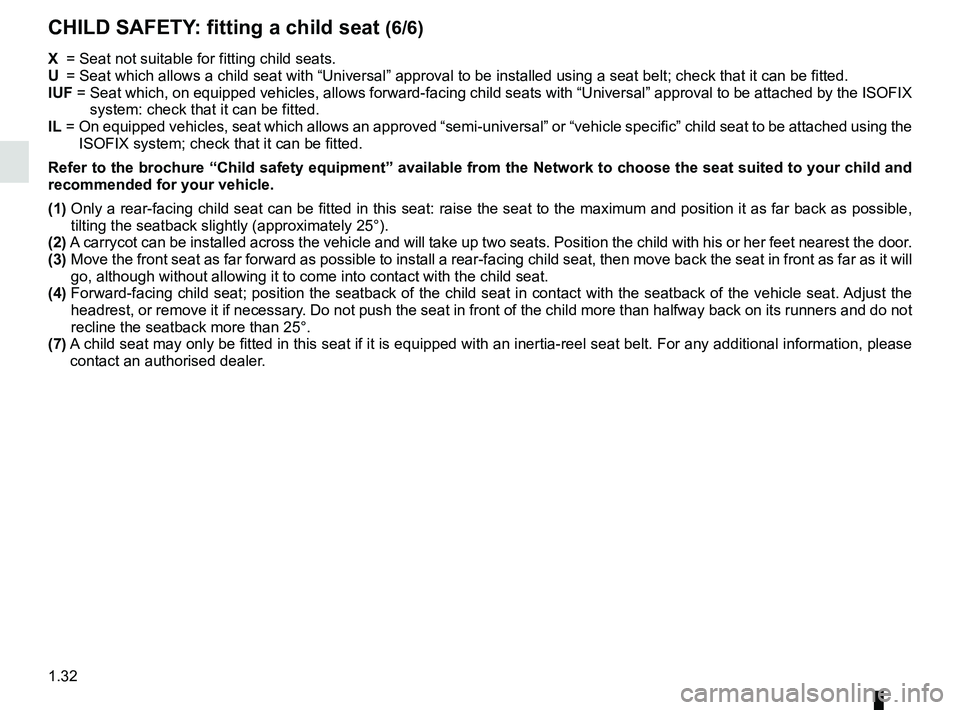
1.32
CHILD SAFETY: fitting a child seat (6/6)
X = Seat not suitable for fitting child seats.
U = Seat which allows a child seat with “Universal” approval to be ins\
talled using a seat belt; check that it can be fitted.
IUF = Seat which, on equipped vehicles, allows forward-facing child seats with\
“Universal” approval to be attached by the ISOFIX
system: check that it can be fitted.
IL = On equipped vehicles, seat which allows an approved “semi-universal”\
or “vehicle specific” child seat to be attached using the
ISOFIX system; check that it can be fitted.
Refer to the brochure “Child safety equipment” available from the Network to choose the \
seat suited to your child and
recommended for your vehicle.
(1) Only a rear-facing child seat can be fitted in this seat: raise the seat\
to the maximum and position it as far back as possible ,
tilting the seatback slightly (approximately 25°).
(2) A carrycot can be installed across the vehicle and will take up two seats\
. Position the child with his or her feet nearest the door.
(3) Move the front seat as far forward as possible to install a rear-facing \
child seat, then move back the seat in front as far as it will
go, although without allowing it to come into contact with the child sea\
t.
(4) Forward-facing child seat; position the seatback of the child seat in co\
ntact with the seatback of the vehicle seat. Adjust the
headrest, or remove it if necessary. Do not push the seat in front of the child more than halfway back on i\
ts runners and do no t
recline the seatback more than 25°.
(7) A child seat may only be fitted in this seat if it is equipped with an in\
ertia-reel seat belt. For any additional information, please
contact an authorised dealer.
Page 39 of 256
![RENAULT DUSTER 2016 Owners Guide 1.33
To deactivate the passenger airbag,
with the ignition off, press and turn
button 1 to the OFF position.
With the ignition switched back on, it is
essential to check that warning light 2,
], i RENAULT DUSTER 2016 Owners Guide 1.33
To deactivate the passenger airbag,
with the ignition off, press and turn
button 1 to the OFF position.
With the ignition switched back on, it is
essential to check that warning light 2,
], i](/img/7/58396/w960_58396-38.png)
1.33
To deactivate the passenger airbag,
with the ignition off, press and turn
button 1 to the OFF position.
With the ignition switched back on, it is
essential to check that warning light 2,
], is lit up on the instrument panel.
This warning light remains conti-
nuously lit to let you know that you
can fit a child seat.
Deactivating the front
passenger air bag
(depending on vehicle)
To fit a rear-facing child seat on the
front passenger seat, you must deacti-
vate the front passenger air bag if your
vehicle is fitted with air bag deactiva-
tion.
CHILD SAFETY: deactivating/activating the front passenger air bag (1/3)
The passenger air bag must
be activated or deactivated
with the ignition off .
If handled when the igni-
tion is on, the warning light
å
comes on.
Switch the ignition off then on again
to reset the air bag in accordance
with the lock position.
2
1
Page 40 of 256

1.34
DANGER
Since operation of the front
passenger airbag is not
compatible with the position
of a rear-facing child seat, NEVER
fit a restraint system for a rear-fac-
ing child in a seat protected by an
ACTIVATED front AIRBAG . This
can cause the CHILD’S DEATH or
SERIOUS INJURY.
CHILD SAFETY: deactivating/activating the front passenger air bag (2/3)
The markings on the dashboard and
labels A on each side of the passenger
sun visor 3 (as shown above) repeat
these instructions.
A
3
A